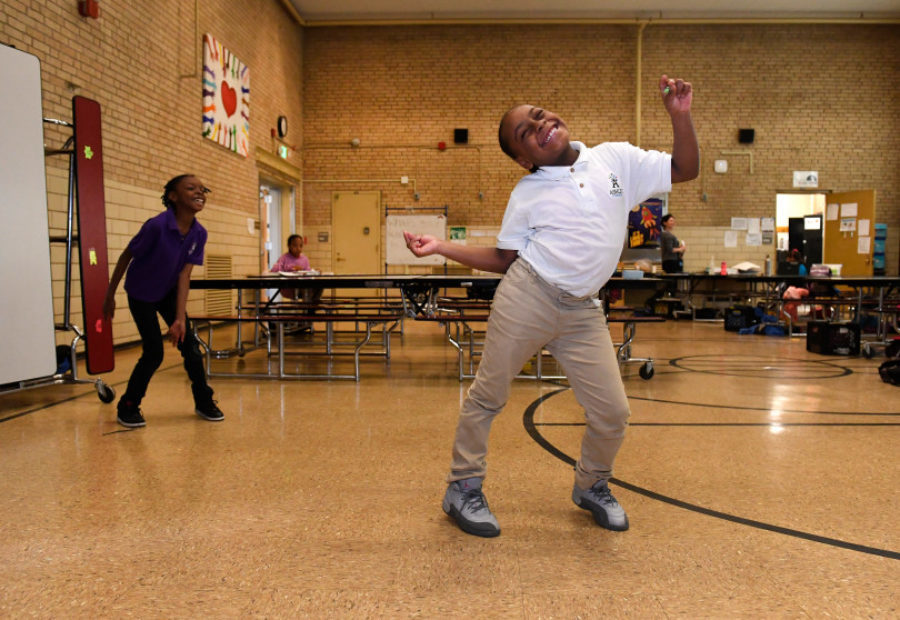Here’s how Colorado schools would spend an extra $100 million (or more) from the state

DENVER, CO - MARCH 10: Hannah Moore, 8, shows off her moves during practice for an after school talent show that is part of the Scholars Unlimited After School program at Ashley Elementary school on March 10, 2017 in Denver, Colorado. Scholars Unlimited is an after school and summer program funded by the 21st Century Community Learning Center Grant, which is threatened to be cut entirely under the White House's budget cuts. The 21st Century Community Learning Center Grant served almost 20,000 students in Colorado between 2015 and 2016 and 76 percent of students showed academic improvement. (Photo by Helen H. Richardson/The Denver Post)
Legislators on the Joint Budget Committee unanimously decided this week to set aside $100 million to “buy down” the budget stabilization factor.
This number – $822 million in 2017-18 – is the amount by which Colorado underfunds its schools when compared to the constitutional requirement that spending on education increase every year based on student count and inflation. It’s more commonly known as the negative factor, though lawmakers are trying to get away from that term.
For several years now, lawmakers have held the negative factor steady, but this year, as Colorado has more money to spend than it has had in a long time, Gov. John Hickenlooper wanted to make a dent in it and requested the $100 million reduction. To be clear, a $100 million reduction in the negative factor is $100 million more that the state would send to districts. Technically, this number will be finalized in a separate piece of legislation, the School Finance Bill, which is coming any day now.
But state Rep. Millie Hamner, the Dillon Democrat who chairs the Joint Budget Committee, wanted to give some reassurance to educators that the money will be there in the budget.
“It would send a message to our K-12 community that we are not spending that money and have set it aside,” she said.
And educators have been clamoring to hear that message. The Colorado School Finance Project has been running a social media campaign for the $100 million buydown using the hashtags #k12needsco and #kidsmattertoo.
The non-profit asked school superintendents around the state to say what they would do with the extra money, which translates to an additional $114 on average for each enrolled student, compared to holding the budget stabilization factor steady. The answers are identified by region, but not by district.
The Joint Budget Committee has set total program spending on education at $7.75 billion before the negative factor is applied, up from $7.45 billion this year, a 4 percent increase. Of total program spending, the state will pay $4.4 billion, with the rest coming from local property taxes. This doesn’t include voter-approved tax increases known as mill levy overrides.
That translates to average per-pupil spending of $7,959, compared to $7,662 this year. A budget stabilization factor of $722 million would yield an average per-pupil amount closer to $8,074.
The smaller budget stabilization factor is significant beyond just one budget year because state law says that this number shouldn’t get larger from one year to the next. However, Colorado superintendents are also pushing for a tax increase and change to the distribution of school money. It will take more than an additional $100 million spread among 870,000 students to address all the needs they identify in their responses to the Colorado School Finance Project.
Hickenlooper had also requested an additional $200 million for the state education fund, with the intention that that money be used to offset costs to districts from proposed changes to the public pension system and expected reductions in property tax revenue in rural communities.
The Joint Budget Committee instead voted to set aside $225 million to deal with costs associated with fixing the Public Employees Retirement Association’s unfunded liability – but in the general fund rather than the state education fund and not specifically to help schools, where retirement costs account for a big chunk of the personnel budget.
The committee also agreed to set aside $30 million to help small rural districts with low tax bases and was supportive of setting aside $10 million to address rural teacher shortages, though some of the details are still being worked out.